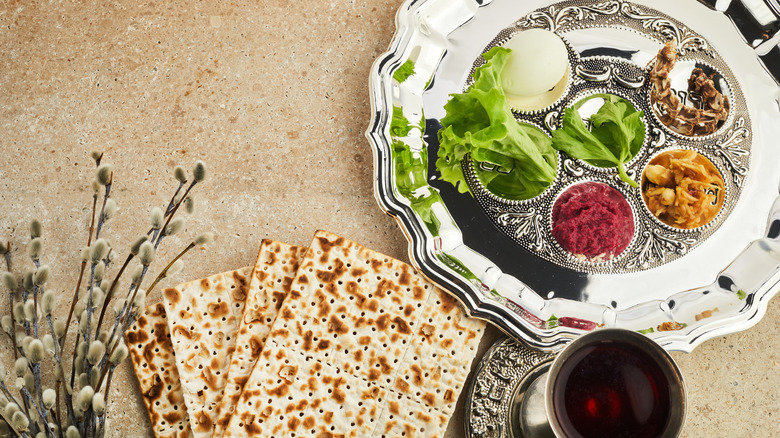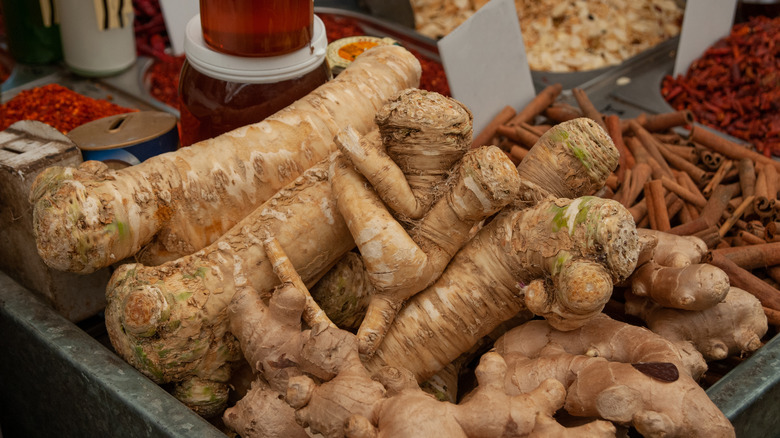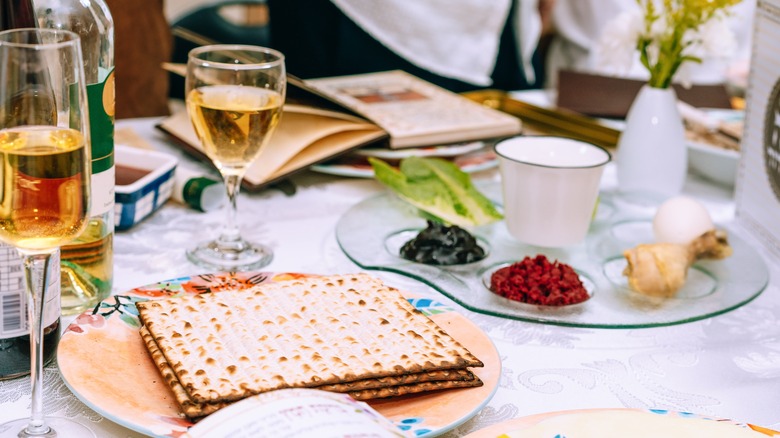The Significance Of The Bitter Herbs At Passover Seder
Passover is one of the most important holidays on the Jewish calendar. The seven (or eight) day holiday celebrates the Hebrews' freedom from slavery in Egypt. It also commemorates the passing over of Israelites before their exodus from Egypt; and each year, either in March or April, Jewish people around the world gather with their families to celebrate Passover. There are several traditional practices, including abstaining from eating leavened bread. But one of the most vital aspects of this holiday is the seder, particularly during the first and second days of Passover.
A traditional seder meal contains six parts, which each represent different aspects of the Jewish Passover. These include beitzah, or an egg, which represents new life; chazeret (or lettuce); zeroa, or bone shank, which symbolizes the Paschal lamb; charoset, a mixture of apple with honey or wine; karpas, which is parsley dipped in saltwater, representing the tears shed by Israelites during their time in slavery; and maror, the bitter herbs that take center stage during Passover, which symbolize the bitter realities of slavery.
The maror is an important part of the seder, and it's often paired with the chazeret and charoset. It's vital to the holiday, which is meant to help Jewish people reflect on a time period that presented both pain and freedom. Beyond commemorating the Jewish people's exodus from Egypt, the holiday encourages people of the Jewish faith to reflect on the bitter history that preceded it.
What is maror?
The maror consists of bitter herbs served on a traditional Passover seder plate. The exact herb differs by region, country, and even family. However, in the United States, most households use horseradish, parsley, chicory, or romaine lettuce. Other possible choices include dandelion greens or clover. The maror is not specific to a single herb, but it's meant to broadly symbolize the suffering of the Jewish people before leaving Egypt. Like other items on a seder plate, the maror can be replaced with an alternative. The zeroa, for example, is often replaced with a beet in vegetarian households where meat is not an option.
But the maror is not meant to stand on its own. The seder plate combines many different aspects of the Jewish holiday to help bring a larger appreciation to the overall historical context of Passover. The maror is often dipped into the charoset, which represents the sweetness of life, and the combination of the two contrasting tastes symbolizes how complex life often is — both bitter and sweet, and often all at once.
Other aspects of Passover
But the seder plate isn't the only food tradition central to Passover. Another food-based tradition is abstinence from leavened bread. This is because, before leaving Egypt, the Jewish people had no time to let bread rise. So, each year at Passover, leavened bread is prohibited, to honor the experiences of the Jewish people upon their expulsion from ancient Egypt. This is the symbolic reason why matzo is eaten during Passover instead of bread. Matzo is a type of flatbread that is unleavened and often crunchy. At a Passover seder, matzo is often eaten both before and with the maror, as a part of the seder dinner. It is essentially the glue, so to speak, that holds the various dishes together.
Another Passover tradition is the afikomen, one of three pieces of matzo typically included in a Passover seder. The afikomen is typically broken in two, and the larger half of the matzo is wrapped up in tissue or a cloth, then hidden. Once it's hidden, children are sent to look for the piece of afikomen. When the piece of matzo is found, everyone at the seder table shares a bite from it. In some households, whoever finds the afikomen is given a small reward. This certainly brings something sweet to the bitter parts of this ritual, and it's a beloved part of Passover. Through food, the maror at Passover seder paints a complicated yet beautiful portrait of a pivotal part of Jewish history and cultural heritage.


